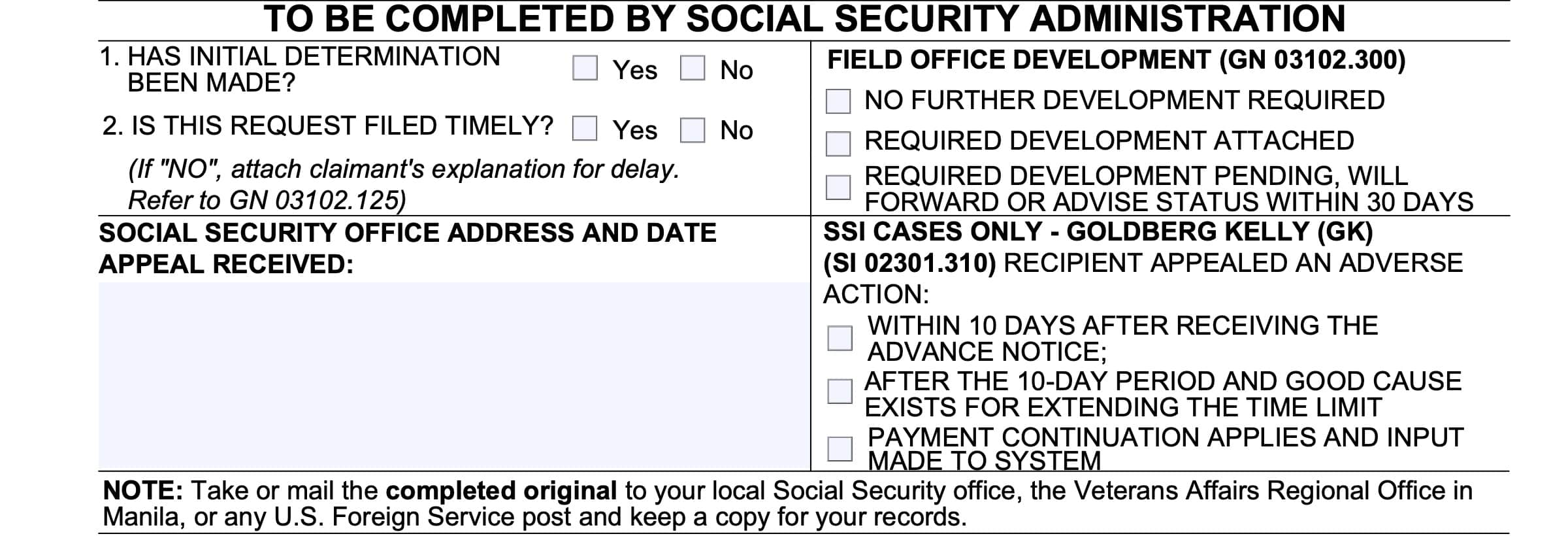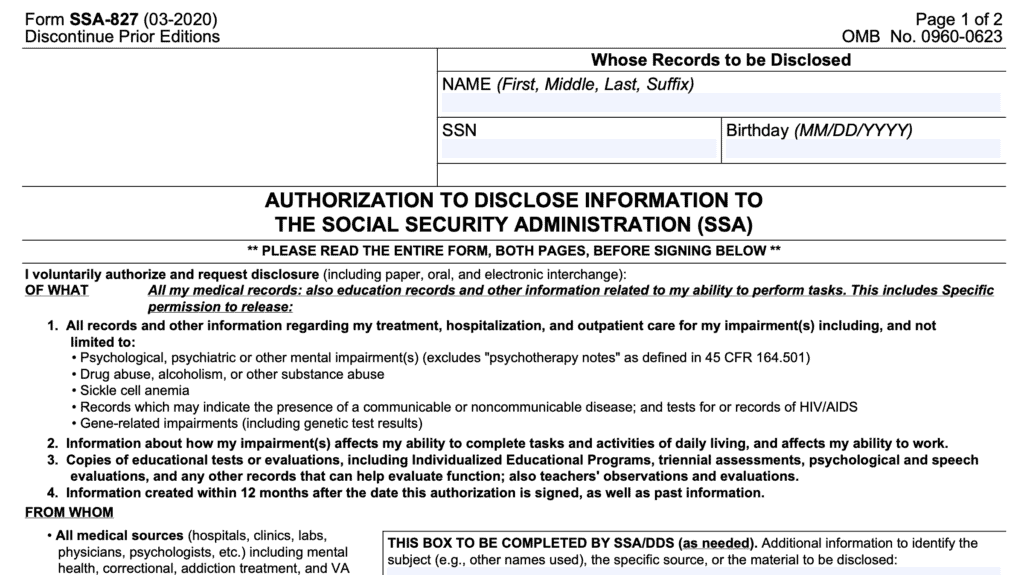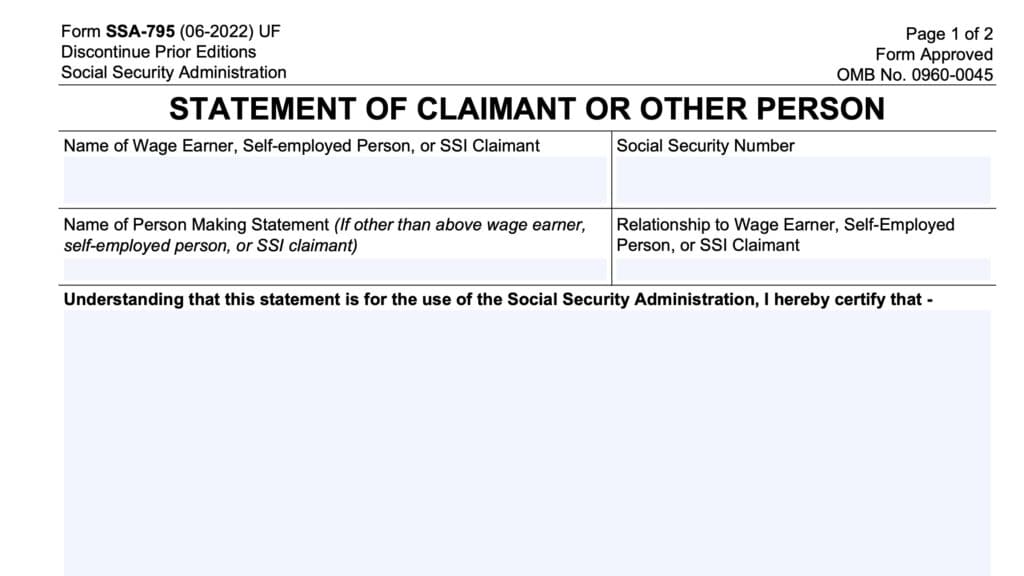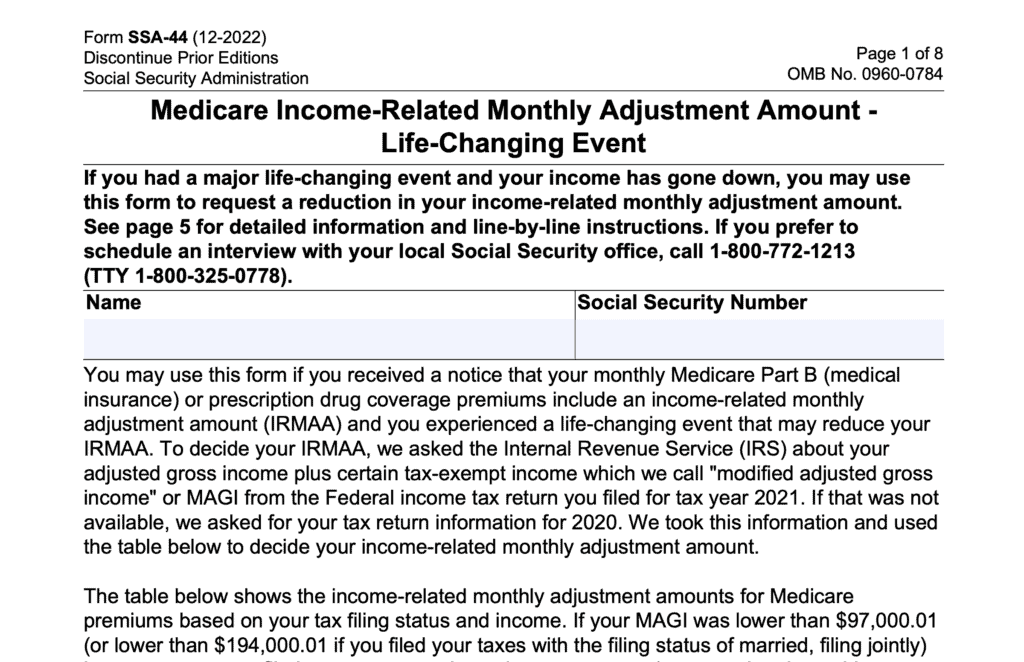Form SSA 561 Instructions
If you’ve received a letter of determination from the Social Security Administration regarding Social Security benefits, you might be wondering how to appeal the SSA’s decision on your initial application. Most appeals can be started by filing Form SSA 561, Request for Reconsideration.
In this article, we’ll cover this form in depth, including:
- How to complete Form SSA 561
- Different types of appeals available to SSI recipients
- Proven tips to help make your appeal more successful
Let’s start by going over how to complete this reconsideration form.
Table of contents
How do I complete Form SSA 561?
This form is fairly straightforward. Let’s start with the claimant information fields at the top.
Claimant information
At the top of the form, you’ll enter information about the reconsideration request.
Claimant’s name
Enter the legal name of the claimant, as it appears on their identity document, such as a driver’s license or unexpired U.S. passport.
Social Security number
Enter the claimant’s Social Security number (SSN), as shown on their Social Security card.
Claim number
If the claim number is different from the claimant’s SSN, then enter the claim number as it appears on the notice from the Social Security Administration.

Issue being appealed
Specify the particular issue that you are appealing the initial determination. Below are examples of issues you might appeal:
- Retirement Survivors Insurance (RSI) benefits
- Social Security Disability Insurance (DI) benefits, also known as SSDI benefits
- Supplemental Security Income (SSI) payments
- Special Veterans Benefits (SVB)
- Health Insurance/Supplementary Medical Insurance (HI/SMI) entitlements
- Lump-sum death payment
- Disability freeze
- Deductions
- Earnings record revision
If you are requesting reconsideration for non-medical concurrent Title II and Title XVI common issues, the request is deemed to apply to both claims, as long as the time limit for appealing either claim has not expired.
Reasons for disagreement
In this section, provide additional information about why you disagree with the determination. If you received a notice of overpayment, you should indicate whether you are questioning:
- The determination of overpayment
- The waiver determination
- Both determinations
The SSA representative will describe any additional evidence that you bring to the local Social Security office or that you send in with your completed form. Be sure to provide additional documentation to support your case.
Ways to appeal
This section applies to Supplemental Security Income (SSI) and Special Veterans Benefits (SVB) only. For these situations, there are three different ways to appeal a determination:
- Case review
- Informal conference
- Formal conference
Let’s take a closer look at each one.
Case review
Case review is a method of reconsideration that involves a complete review of all evidence in the case file. Regardless of the type of disability claim being reviewed, case review is allowed in all cases.
This may include new evidence:
- Submitted by the claimant
- Submitted by an appointed representative, or
- Otherwise secured by the SSA
When you request a case review, you should have the opportunity to provide additional information or required documents that might support your case. However, if you meet at the local SSA office, the person you meet probably will not be the same person who reviews your case.
If you require extra time to provide additional evidence, the SSA office should give you at least 10 days, according to the SSA Program Operations Manual.
If you need additional time beyond that, the SSA representative may ask you to specify how much time you need. However, they will probably ask you to commit to a specific number of days.
If you need assistance obtaining specific documents, it’s a good idea to ask. The SSA office may be able to assist you if:
- You have difficulty obtaining the document, and
- It is easier for the federal government to obtain it on your behalf
Once all the required documents and information is in place, the case review should be complete within 5 working days of the date that all evidence is submitted.

Informal conference
If you are an SSI recipient, you may request an informal conference in any SSI case that does not involve a medical condition. For SVB recipients, you can only request an informal conference if the SSA has indicated that they are lowering or stopping your SVB payment.
In an informal conference, you are able to meet with the person who decides your case. You can also do the following:
- Explain your position or circumstances
- Provide additional facts or documentation to support your case
- Bring additional witnesses to provide evidence on your behalf
SSI recipients
Federal court rulings indicate that an SSI recipient who has requested a waiver of overpayment recovery is entitled to an opportunity for a personal conference with the decision maker if the federal government cannot approve the waiver based upon the initial waiver request.
Formal conference
SSI and SVB recipients may only request a formal conference if the SSA has determined that they are either stopping or lowering your SSI or SVB payments.
In addition to your informal conference entitlements, you may use a formal conference to:
- Cross-examine an adverse witness
- Request the SSA produce the adverse witness
- Subpoena the adverse witness, if necessary
For either an informal or formal conference, the SSA should send you written notification of the conference date, location, and time no less than 10 days before the conference.
Claimant contact information
In the contact information field, you should complete as much information as possible. This includes:
- Claimant’s mailing address
- Can be residential address or P.O. Box
- Include city, state, and zip code
- Phone number
- Date you completed the form
As the claimant, you should sign the form. However, the SSA does not require a signature to process this form. The SSA should process the request for reconsideration as long as:
- You submit a written request that clearly shows dissatisfaction with the determination, and
- It is clear that the written request originated with the claimant

If you are working with a claimant representative, you’ll need to include the representative’s information, including:
- Current name
- Mailing address
- Telephone number
Social Security Administration fields
At the bottom of the form, there is a section marked, To Be Completed By Social Security Administration. Although you are not expected to complete these fields, it’s worth taking a closer look for a more complete understanding.
Has Initial Determination Been Made?
If the SSA has already made an initial determination, then they will accept your request. However, if you are submitting a request before the initial determination, the SSA will probably recommend that you wait until you’ve received the initial determination.
The SSA may also dismiss the request for reconsideration for any of the following grounds:
- Request not based on an initial determination,
- Request filed by improper requestor,
- Request filed prematurely,
- Request filed late and good cause for late filing cannot be found, or
- Examples of good cause can include illness, death of an immediate family member, or not receiving the notice
- Request filed on a SSA-561-U2 when it is clear that the individual only intended to request information, reduce their overpayment recovery amount, or waive repayment of the overpayment.
Is this Request Filed Timely?
Generally, the SSA will expect any request to be made in a timely manner. According to the SSA, timely manner depends on the type of request:
- Statutory benefit continuation or Goldberg Kelly payment continuation: Request must be made within 10 days of the overpayment notice
- For appeals: Request must be made within 60 days of the date the notice was issued
Social Security Office Address and Date Appeal Received
This field, in the lower left-hand side of Form 561-U2, is used to document the address of the SSA office that received the appeal, as well as the receipt date.
Field Office Development
In this section, the field office may select one of three different options:
- No further development required
- Required development attached
- Required development pending, will forward or advise status within 30 days
In other words, the field office will indicate whether there is further development required. But what is required development?
Required development
Further development may include any of the following:
- Asking the claimant for all evidence he or she has or can obtain
- Fully developing questions raised by the claimant
- Documenting evidence requested but not obtained while outlining efforts to obtain that evidence
- Requesting any prior folders needed via email or administrative message
- Forwarding reconsideration request with related development to the appropriate office

SSI Cases Only
In SSI cases, there is a section for the SSA to mark the action taken after a claimant has appealed an adverse action. This is based upon a landmark Supreme Court verdict, Goldberg V. Kelly, in which the Supreme Court declared that states must afford public aid recipients a pre-termination evidentiary hearing before discontinuing their aid.
In other words, if you’re receiving public assistance, and you’re expecting financial hardship if your aid is terminated, then you have the right to a formal appeal.
Goldberg Kelly also set certain conditions to maintain payments while the appeal is ongoing, under the following circumstances:
- Reconsideration appeal was received within 10 days of receiving advance notice
- Appeal was received after the 10-day period, but good cause exists for an extension
This doesn’t automatically accept your appeal. It simply means that you will continue to receive payments until the appeal has been formally exhausted, or your payments have been completely restored.
The SSA will also indicate whether they made the payment continuation, based upon whether you meet either of the previous two criteria.
Now that we’ve covered the form, let’s go over some helpful tips that will give you a better chance for success.
5 Tips for a Successful Appeal
I’ve helped hundreds of people navigate government bureaucracy. Whether it’s with the Internal Revenue Service, VA Department, or Social Security Administration, there are some simple truths.
One of them is this: Most government employees want to help you. But they can only do what their job allows them to do.
So here are 5 things that
Tip #1: Know what is expected of you.
The Social Security operations manual is pretty straightforward. It clearly tells employees how to process virtually every single SSA form in existence. Furthermore, it will tell an employee:
- What the employee should do, and how to do it
- What the claimant should do, and how the claimant should do it
The first part is frustrating for people who don’t understand how the decision-making process works. The second part is frustrating for people who think that it’s someone else’s responsibility, when it’s not.
The good news is that you can understand both sides of this, by reading articles like this one. Or going online to the SSA website to learn more about the specific process that’s important to you.
Tip #2: Understand why your original request was not successful.
If you received the determination that you wanted, you wouldn’t be reading this article. At the same time, almost all of the information you need to remedy the situation is probably in your determination letter.
Take the time to understand the denial letter. In most cases, the main reason that the request is denied is easy to understand. This could be things like:
- Not having enough information to process the paperwork
- Incorrect information provided
- Lack of response from the recipient
- Lack of acceptable documents
If you take the time to understand why your original request didn’t succeed, the solution might be easier than you thought. And if not, ask for help.
Tip #3: Communicate, communicate, communicate
Communication is the key to understanding the problem that you’re facing, as well as resolving it. The SSA might be frustrating to deal with (long wait times, unsatisfactory responses, etc.).
But when it comes to processing the required paperwork for important SSA programs, you don’t really have many alternatives. Take additional time to remain on hold, or schedule an appointment with your local office.
And if you do go to your local office, make sure you bring all of your appropriate paperwork.
Tip #4: Bring All Required Documents To Your Local SSA Office.
When it comes to processing paperwork, the SSA states that you must provide an original document or certified copy of certain key documents.
This could be proof of identity documents, to verify that you are the person that you say you are. Examples of acceptable documents include:
- Unexpired U.S. passport or passport card
- Birth certificate
- Could also accept Certificate of Citizenship or Consular Report of Birth Abroad
- Driver’s license or identification card with photograph
You might be asked for proof of something else. For example, with Form SSA-44, you might be asked to present documentation of a life-changing event that impacted you. In that case, you might need to provide supporting evidence, such as:
- Marriage certificate
- Certified divorce decree
- Death certificate
Make sure you understand the situation, and bring the necessary documents with you to your appointment.
Finally, make sure you keep the original document, while the SSA office makes copies for their records.
Tip #5: Stay Engaged.
Don’t just file paperwork and forget about it. Make a plan for following up.
If you talk to a person, make sure you don’t end the conversation until you know:
- What the next action is supposed to be
- Who is responsible for that action
- When that action should take place
- What you should do if that action doesn’t occur
That way, you can keep track of this over time, but without having to stress out about it every day.
Video walkthrough
Watch this instructional video to learn more about filing your request for reconsideration with Form SSA-561.
Frequently asked questions
Below are some of the most popular questions people ask about this form.
You may use Form SSA 561 to ask the Social Security Administration to reconsider determination made for non-medical reasons. Examples of non-medical determinations may include denial of benefits, overpayment of benefits decisions, or reduction in benefit amount.
Usually, your notice of initial determination will give you specific instructions on how to file your appeal. However, you may obtain more information about how to successfully go through this paperwork by making an appointment at your local Social Security office.
Where can I find Form SSA 561?
You can find printable forms, such as Form SSA-561 on the SSA.gov website. For your convenience, we’ve included the latest version of Form SSA 561 here, in this article.



